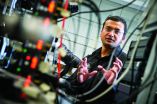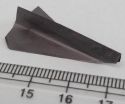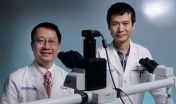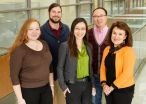INFORMATION:
About The University of Texas at Arlington
The University of Texas at Arlington is a comprehensive research institution and the second largest institution in The University of Texas System. The Chronicle of Higher Education ranked UT Arlington as the seventh fastest-growing public research university in 2013. U.S. News & World Report ranks UT Arlington fifth in the nation for undergraduate diversity. Visit http://www.uta.edu to learn more. Follow #UTAdna on Twitter.
New publications detail photonics advances by UT Arlington physics team
2014-11-11
(Press-News.org) A University of Texas at Arlington physics team is using their expertise in the field of optics and photonics to advance new methods in areas such as mapping the neural circuitry of the brain and guiding neurons to potentially repair damage in the body.
Samarendra Mohanty, an assistant professor of physics, leads the Biophysics and Physiology Lab in the UT Arlington College of Science. He is co-author on two papers published this month. In one published by the online journal PLOS ONE Nov. 10, researchers in Mohanty's lab described using a method called "two-photon optogenetic stimulation" to carry out in-depth optogenetic stimulation of brain neurons in mouse models - a first in vivo, or in the body, example of the technology.
The second paper was published by Nature Scientific Reports this month and details how scientists used weakly-focused, near infrared laser beams to guide axons to form loops on itself, termed as self-fasciculation, in the lab. Axons are the shafts of neurons, on the tips of which connections are made with other neurons or cells.
"Our innovative approach and expertise in the use of optical tools is making it possible for us to construct, manipulate, transform, modulate and even detect structure and function of neural circuits as never before," said Mohanty. "These publications, along with others this year, chronicle this work and demonstrate the many ways in which our lab is using technical know-how to further research goals."
Alex Weiss, professor and chairman of the UT Arlington Physics Department, said Mohanty's prolific team "continues to demonstrate their ability to break boundaries and innovate new methods."
"Their work with other departments within the College of Science and the College of Engineering strengthens their research and furthers the spirit of collaboration at UT Arlington," Weiss said.
Kamal R. Dhakal, a Ph.D. student working in the Mohanty lab is lead author on the PLOS ONE paper, which is called "Non-scanning fiber-optic near infrared beam led two-photon optogenetic stimulation in-vivo." The research paper describes using near-infrared light delivered by fiber optics to stimulate a light sensitive protein called ChR2 that can be delivered into living cells and neurons. Last month, Dhakal and Bryan Black in the Mohanty lab reported in Nature Scientific Reports the use of near-infrared laser beam to stain neurons with impermeable molecules to visualize neural connectivity.
These technologies would be useful in brain mapping initiatives championed by the scientific community and President Barack Obama. Eventually, researchers hope more knowledge about neural circuitry in the brain could lead to new treatments for conditions such as chronic pain and drug addiction.
"Scientists are trying to find out about the connectivity of neuronal circuitry in different regions of the brain, but that information is not sufficient, unless we examine how those connections function. That's where two-photon optogenetics comes into play," Dhakal said.
Because the fiber-optic two-photon optogenetic stimulation, or FO-TPOS, uses near infrared light instead of a visible beam, it can surpass the penetration abilities a conventional single-photon beam that uses visible light, Mohanty said. The FO-TPOS also avoids tissue damage that would be caused by using electrical pulses to map circuitry, another previous method.
Other co-authors on the PLOS ONE paper are Mohanty students Ling Gu and Shivaranjani Shivalingaiah; Linda Perrotti, an associate professor of psychology at UT Arlington and her students Torry S. Dennis and Samara A. Morris-Bobzean; and Ting Li, of the University of Electronic Science & Technology of China. The paper is available here: http://www.plosone.org/article/info%3Adoi%2F10.1371%2Fjournal.pone.0111488.
The Nature Scientific Reports paper produced by Mohanty's lab and published online Nov. 7 is called "Loop formation and self-fasciculation of cortical axon using photonic guidance at long working distance." It also builds on previous work the lab has done using near-infrared laser beams to guide axon growth, both by pushing and pulling the growth area or "growth cone."
Mohanty said the paper demonstrates the first use of light, or any other method, to achieve looping or bundling of axon on itself.
"Besides its potential impact on medicine, our results disapproves existing biological hypothesis. It has also significant implication on physical properties of axon," Mohanty said.
Argha Mondal, a visiting student in Mohanty's lab, is lead author on the new Nature Scientific Reports paper. Other co-authors are Bryan Black, another graduate student, and Young-tae Kim, an associate professor in the UT Arlington College of Engineering Department of Bioengineering. It is available here: http://www.nature.com/srep/2014/141107/srep06902/full/srep06902.html.
Mohanty's lab is currently supported by a $384,269 two-year grant from the National Institutes of Health National Institute of Neurological Disorders and Strokes.
ELSE PRESS RELEASES FROM THIS DATE:
Bending -- but not breaking -- in search of new materials
2014-11-11
Making a paper airplane in school used to mean trouble. Today it signals a promising discovery in materials science research that could help next-generation technology -like wearable energy storage devices- get off the ground. Researchers at Drexel University and Dalian University of Technology in China have chemically engineered a new, electrically conductive nanomaterial that is flexible enough to fold, but strong enough to support many times its own weight. They believe it can be used to improve electrical energy storage, water filtration and radiofrequency shielding ...
Progress in bipolar disorder -- update from Harvard Review of Psychiatry
2014-11-11
November 11, 2014 - Several lines of research have opened exciting new frontiers in scientific understanding and clinical management of bipolar disorder. Recent advances in bipolar disease research are described in this month's special issue of Harvard Review of Psychiatry. The journal is published by Lippincott Williams & Wilkins, a part of Wolters Kluwer Health.
Bipolar disease is a "prevalent, complex, and hard-to-treat illness [leading] to extreme and erratic shifts of mood, thinking, and behavior, with a very high risk of suicide as well as increased risks of dying ...
Penn-Dresden study blocks multiple sclerosis relapses in mice
2014-11-11
In multiple sclerosis, the immune system goes rogue, improperly attacking the body's own central nervous system. Mobility problems and cognitive impairments may arise as the nerve cells become damaged.
In a new study, researchers from the University of Pennsylvania and co-investigators have identified a key protein that is able to reduce the severity of a disease equivalent to MS in mice. This molecule, Del-1, is the same regulatory protein that has been found to prevent inflammation and bone loss in a mouse model of gum disease.
"We see that two completely different ...
Study identifying cell of origin for large, disfiguring nerve tumors lays groundwork for development
2014-11-11
DALLAS - November 11, 2014 - UT Southwestern Medical Center researchers have determined the specific type of cell that gives rise to large, disfiguring tumors called plexiform neurofibromas, a finding that could lead to new therapies for preventing growth of these tumors.
"This advance provides new insight into the steps that lead to tumor development and suggests ways to develop therapies to prevent neurofibroma formation where none exist today," said Dr. Lu Le, Assistant Professor of Dermatology at UT Southwestern and senior author of the study, published online and ...
Penn Vet team pieces together signaling pathway leading to obesity
2014-11-11
As scientists probe the molecular underpinnings of why some people are prone to obesity and some to leanness, they are discovering that weight maintenance is more complicated than the old "calories in, calories out" adage.
A team of researchers led by the University of Pennsylvania School of Veterinary Medicine's Kendra K. Bence have now drawn connections between known regulators of body mass, pointing to possible treatments for obesity and metabolic disorders.
Their work also presents intriguing clues that these same molecular pathways may play a role in learning ...
Salivary mucins play active role to fight cavities
2014-11-11
Salivary mucins, key components of mucus, actively protect the teeth from the cariogenic bacterium, Streptococcus mutans, according to research published ahead of print in Applied and Environmental Microbiology. The research suggests that bolstering native defenses might be a better way to fight dental caries than relying on exogenous materials, such as sealants and fluoride treatment, says first author Erica Shapiro Frenkel, of Harvard University, Cambridge, MA.
S. mutans attaches to teeth using sticky polymers that it produces, eventually forming a biofilm, a protected ...
This Week From AGU: Volcano hazards and the role of westerly wind bursts in El Niño
2014-11-11
From this week's Eos: Scientists Engage With the Public During Lava Flow Threat
On 27 June, lava from Kīlauea, an active volcano on the island of Hawai`i, began flowing to the northeast, threatening the residents in Pāhoa, a community in the District of Puna, as well as the only highway accessible to this area. Scientists from the U.S. Geological Survey's Hawaiian Volcano Observatory (HVO) and the Hawai`i County Civil Defense have been monitoring the volcano's lava flow and communicating with affected residents through public meetings since 24 August. Eos recently ...
Majority of people -- including health professionals -- struggle to identify obesity
2014-11-11
The majority of people - including healthcare professionals - are unable to visually identify whether a person is a healthy weight, overweight or obese according to research by psychologists at the University of Liverpool.
Researchers from the University's Institute of Psychology, Health and Society asked participants to look at photographs of male models and categorise whether they were a healthy weight, overweight or obese according to World Health Organisation (WHO) Body Mass Index (BMI) guidelines.
They found that the majority of participants were unable to correctly ...
Microtubes create cozy space for neurons to grow, and grow fast
2014-11-11
CHAMPAIGN, Ill. -- Tiny, thin microtubes could provide a scaffold for neuron cultures to grow so that researchers can study neural networks, their growth and repair, yielding insights into treatment for degenerative neurological conditions or restoring nerve connections after injury.
Researchers at the University of Illinois at Urbana-Champaign and the University of Wisconsin-Madison created the microtube platform to study neuron growth. They posit that the microtubes could one day be implanted like stents to promote neuron regrowth at injury sites or to treat disease.
"This ...
Study: Farmers and scientists divided over climate change
2014-11-11
WEST LAFAYETTE, Ind. - Crop producers and scientists hold deeply different views on climate change and its possible causes, a study by Purdue and Iowa State universities shows.
Associate professor of natural resource social science Linda Prokopy and fellow researchers surveyed 6,795 people in the agricultural sector in 2011-2012 to determine their beliefs about climate change and whether variation in the climate is triggered by human activities, natural causes or an equal combination of both.
More than 90 percent of the scientists and climatologists surveyed said they ...






